I’m just a mean green mother from outer space and I’m bad.
Know which version of Little Shop of Horrors you’re watching before sitting down because you might be in for a surprise if you don’t. Having grown up with the theatrical cut often finding its way onto my television, I have a clear picture of how the story is supposed to end. There’s a visual reprise of the “Somewhere That’s Green” sequence with bright lights, mowed grass, and an outrageously strange bud popping out from the middle of a happily-ever-after garden. It’s not how Howard Ashman‘s original off-Broadway musical ended. Nor is it how he and director Frank Oz envisioned ending their big budget cinematic adaptation. But it is what audiences received and ultimately what those who enjoyed it still expect. You can thank a San Jose test screening.
To therefore find yourself drowning in nostalgia as each Alan Menken song unfolds (I forgot how great the likes of “Skid Row (Downtown)” and “Suddenly, Seymour” are) only to quizzically tilt your head as the climax starts changing ever so slightly becomes quite a shock. You can blame a faulty memory only so long before you begin to remember those black and white stills of an insanely bleak finale thought to be lost forever. I personally didn’t realize the actual footage was found in 2012 let alone restored to match the rest of the film and become available for public consumption. So, when that American flag appears with Crystal (Tichina Arnold), Ronette (Michelle Weeks), and Chiffon (Tisha Campbell) preparing us for the apocalypse, I was left in awe.
Why? Because it’s a show-stopping bit of practical effect chaos (accomplished with miniatures) that provides the sort of closure this story demands. This is a cast of very flawed characters of which many toe the line of psychopathy and abuse. Just because Seymour Krelborn (Rick Moranis) is a consummate “nice guy” doesn’t mean he deserves the “girl” (Ellen Greene‘s Audrey). Even if he didn’t eventually find himself feeding his alien plant Audrey II human flesh, he still proves himself unworthy of the benefit of the doubt the moment he embraces fame regardless of its cost. Yes, he’s been exploited and tormented by his father figure and boss Mushnik (Vincent Gardenia), but his actions remain his own. And just as everyone ultimately pays the piper, so too should he.

The only tragic figure is Audrey—a woman who doesn’t believe she merits anything nice. It’s why she stays in an abusive relationship with sadist Orin Scrivello D.D.S. (Steve Martin). It’s why she never thinks of Seymour as a romantic partner due to him being “too good for her.” And it’s why she can lay dying with a smile on her face, thinking that sacrificing her life for his success might be enough to make her suffering worthwhile. Not only is she used by every man in her life (Orin’s punching bag sex toy, Mushnik’s underpaid laborer, and Seymour’s excuse to perform evil deeds), but she also fantasizes about epitomizing the patriarchal standard of womanhood: Betty Crocker meets Donna Reed. The optics here are abysmal.
While I’d like to blame Roger Corman‘s original 1960 B-movie The Little Shop of Horrors, as written by Charles B. Griffith, a quick skim through its synopsis reveals it was Ashman’s idea instead. You can stomach it if the musical is self-aware enough to realize giving Audrey as a prize to Seymour isn’t the way to go. She’s used and abused one last time (by the writer), but at least the men face consequences. That test audiences couldn’t see this truth before going further to demand Audrey become that prize says a lot about America’s collective consciousness back then. Add the optics of it all taking place on “Skid Row” with escape rather than rehabilitation propped up as victory and you have Ronald Regan’s politics in a nutshell.
Humanity doesn’t deserve to live with that attitude. They should be wiped out by an alien invasion. What we’re watching is supposed to be a cautionary tale, not the Men’s Rights activist scree the theatrical cut unwittingly becomes. This is a story about greed and lust with Audrey II (The Four Tops’ Levi Stubbs) playing a Monkey’s Paw genie who gives mankind exactly what it seems hellbent on causing: its own destruction. Feed the plant the dentist who gets off on inflicting pain (Martin is fantastic, especially once glee turns to revulsion opposite Bill Murray‘s masochist as the latter’s enjoyment ruins the former’s fun). Feed it the slave driver who sees nothing but dollar signs (Gardenia’s avarice is palpable). And feed it the opportunist willing to sell his soul.

It’s amazing what changing twenty or so minutes of a film can do to totally turn it on its head. The film is pretty bleak overall with its depiction of poverty anyway, so it’s not like the original ending is contextually strange. Maybe the inherent humor to Arnold, Weeks, and Campbell’s Greek chorus of Motown singers and Moranis and Greene’s infectiously shy love tricks audiences into thinking it’s not, but that’s more of an indictment on the viewer than the piece. Little Shop of Horrors showcases a deteriorating world of impoverished victims and cruel oppressors—one too often forgotten until it can be stolen and resold for a profit. Seymour’s shame isn’t therefore being Audrey II’s captive. It’s a product of his guilt for being just as bloodthirsty.
He’s a wolf in sheep’s clothing that has fooled even himself from acknowledging that reality. Only his demise can offset his actions. That it comes in the form of a flytrap-like botanical nightmare simply adds to the comedy and terror thanks to an unforgettable feat of puppetry and filmmaking. Oz uses zero composites for Mushnik’s flower shop—that beast is in-frame with the actors throughout and there isn’t a moment that feels false as a result. Couple that artistry with the inspired casting of Moranis, the unparalleled voice of Greene, and the hilarity of a very game Martin and Murray and it’s tough not to get swept up in the fantastical nature of this morality tale. So, trash that “happy ending” for good. Sometimes we deserve the flood.

Watched in conjunction with my Buffalo, NY film series Cultivate Cinema Circle.

